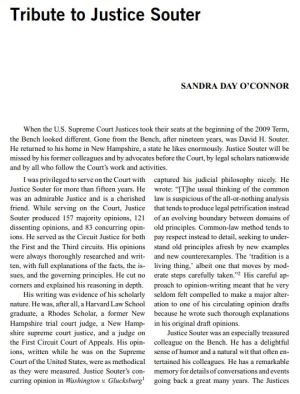By Justice Sandra Day O'Connor
Tribute to Justice Souter
May 21, 2010

Other pages in the O'Connor Institute Online Archive mentioned in this article:
| NAME / TITLE | TYPE |
|---|---|
| David Souter | Justice |
Article Text
(Excerpt)
Abstract
When the U.S. Supreme Court Justices took their seats at the beginning of the 2009 Term, the Bench looked different. Gone from the Bench, after nineteen years, was David H. Souter. He returned to his home in New Hampshire, a state he likes enormously. Justice Souter will be missed by his former colleagues and by advocates before the Court, by legal scholars nationwide and by all who follow the Court's work and activities.
I was privileged to serve on the Court with Justice Souter for more than fifteen years. He was an admirable Justice and is a cherished friend. While serving on the Court, Justice Souter produced 157 majority opinions, 121 dissenting opinions, and 83 concurring opinions. He served as the Circuit Justice for both the First and the Third circuits. His opinions were always thoroughly researched and written, with full explanations of the facts, the issues, and the governing principles. He cut no corners and explained his reasoning in depth.
His writing was evidence of his scholarly nature. He was, after all, a Harvard Law School graduate, a Rhodes Scholar, a former New Hampshire trial court judge, a New Hampshire supreme court justice, and a judge on the First Circuit Court of Appeals. His opinions, written while he was on the Supreme Court of the United States, were as methodical as they were measured. Justice Souter's concurring opinion in Washington v. Glucksburg1 captured his judicial philosophy nicely. He wrote: “ [T]he usual thinking of the common
